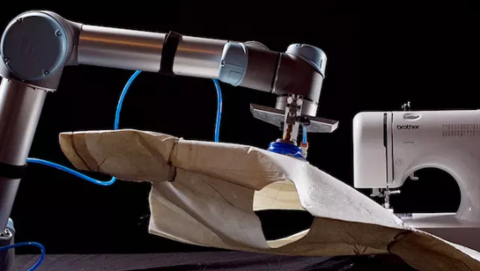“Apparel production, especially fast fashion, requires precision production and fast delivery at a very low cost. All companies are eager to find the cheapest manpower and therefore have no intention of investing in new production technologies.â€
In 2017, the total sales of the global apparel market will soon exceed $1.4 trillion. But what is surprising is that this huge industry is not as modern as it is supposed to be, especially in production. Although professional robots have learned to weave or cut, the more complicated assembly and sewing work can still rely solely on labor.
This year's 30-year-old American Jonathan Zornow wants to solve this problem. He was originally a web development programmer, set up in 2015 in Seattle venture company called Sewbo, the only product that people Sewbo sewing machines, it is said to be completed within half an hour a separate basic pieces (such as T The production of shirts.
According to the company's official website, Sewbo's working principle is actually very simple. The difficulty in assembling the sewing thread is mainly because the fabric is too soft and it is difficult to operate accurately on the machine. So Sewbo's complete system consists of three parts: a robotic arm from a Danish company, Universal Robot, a traditional sewing machine, and a reusable thermoplastic solvent. Their total cost is between $27,000 and $35,000.
Obviously, the most critical of the systems is the thermoplastic solvent. This substance is also very common in 3D printing, it can become as hard as steel cloth, easy machine operation, and can be dissolved in water at the end of the process, restore the original appearance of the fabric. What the robot arm needs to do is no different from dealing with metal products: firstly weld the two hardened fabrics with an ultrasonic welder, then stuff them into an industrial sewing machine to sew, and finally soften the sewed clothes in hot water. .
Although the company was founded only one year ago, Jonathan Zornow said that he has received a considerable number of orders from overseas markets.
“I dare to say with confidence that if the system is placed in a real production environment, it can reach the same speed as a regular sewing machine. And it can work 24 hours a day, while ensuring basic error-free.†He Fastcompany.com said.

However, from the current situation, there are still many problems to be solved in order to promote this sewing robot. First, thermoplastic solvents have one drawback: to achieve a hardening effect, the fabric must be completely saturated. Therefore, Sewbow cannot handle wool and leather with high water resistance.
Another problem is that each basic item takes half an hour to complete, but it costs $27,000 to $35,000, and does not include the cost of long-term maintenance. Compared to cheap labor in China and Southeast Asia, the system seems to have only long-term investment to create cost advantages for employers. In general, clothing brands are also more willing to put large investments in channels or marketing rather than on cheap labor.
Atnyel Guedj is the Purchasing Manager of Delta Galil Industries, a multinational factory group. He has reservations about Sewbow: "I haven't seen anyone in the US who is willing to spend money on expensive production machines. It is very difficult to reverse the current industry trends - clothing production, especially fast fashion, needs to be extremely Low cost to complete precision production and fast delivery. The profits are so thin, all companies are eager to find the cheapest manpower, so they are also unwilling to invest in new production technology. This is why even Chinese companies are looking for Vietnam, Bangladesh, Ethiopia Foreign packages such as Erbia are produced."
However, combined with the background of the US government's “manufacturing returnâ€, Sewbo may also find some opportunities in the local market. According to the American Apparel & Footwear Association, 97% of apparel in the country is currently manufactured overseas. If it is necessary to move back, the local expensive labor costs mean that the clothing company must enhance its competitiveness by increasing the efficiency of the production process and shortening the pressure on the supply chain, just like Adidas' new factory “Speedfactory†in Ansbach, Germany.
In the long run, manufacturing innovation and corporate investment in mid- to high-end manufacturing are also a matter of time, but it will take time.
Fake Fur Coats,Faux Fur Jacket,Ivory Fur Coat,Warm Fur Jacket
SHAOXING YINBO IMP&EXP CO.,LTD , https://www.yinbotex.com